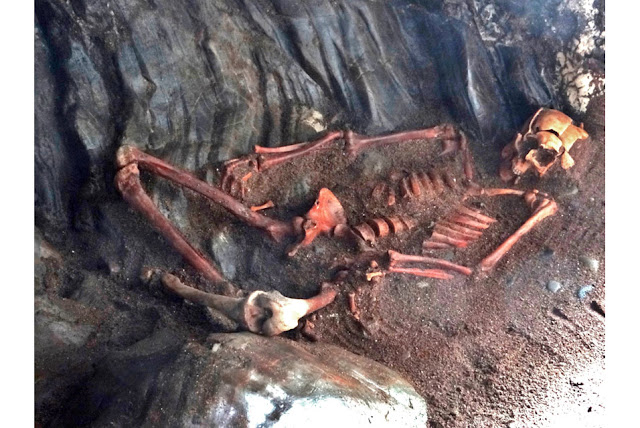If you look at his skull, you can see the violence. According to the University of Dundee's Professor Black he suffered at least five severe blows to the head.
“The first impact was by a circular cross-section implement that broke his teeth on the right side. The second may have been the same implement, used like a fighting stick which broke his jaw on the left. The third resulted in fracturing to the back of his head as he fell from the blow to his jaw with a tremendous force possibly onto a hard object perhaps stone.
“The fourth impact was intended to end his life as probably the same weapon was driven through his skull from one side and out the other as he lay on the ground. The fifth was not in keeping with the injuries caused in the other four where a hole, larger than that caused by the previous weapon, was made in the top of the skull.”He was then buried with considerable car at the back of a cage, possibly by friends. Quite gruesome isn't it?.
I have some reservations about the use of digital imaging techniques, although I recognise their value. The difficulty is that the power of the image can fix a picture in your mind that risks over-riding the evidence, creating prejudices. Neanderthal man is an example that comes to mind.
That said, the power of digital techniques in bring the past alive cannot be denied.









4 comments:
I wonder where I have seen him before. He looks like Carol. Can't be her brother. One of her ancestors perhaps?
Yes, I call bulldust on the ability to "digitally reconstruct" the likeness. There's several "boneyards" world wide where bodies are buried, then studied for rate of decomposition etc. apparently. I'm wondering if these digital artists are ever tested for accuracy by producing a reproduction of one of those known (and I assume previously photographed) corpses?
Also, it just seems weird that these "reconstructions" miraculously provide an agreeable image - if that's what's required for publicity - but a disagreeable image, if the body is of some possibly nefarious fellow. Science?
Winton, you please leave Carol alone. She resolves all my Telstra problems :)
kvd
@kvd I'm with you.
I did see an article once in a computer magazine which said that software was being developed exactly that way - take photographs and skull scans and build a matching database. However, I suspect that environment would play a part too, and therein lies my problem with digital reconstructions. If the database made up of Macdonalds-eating Americans is then applied to a thousand year old corpse, I'd be expecting a certain systemic inaccuracy.
And they've gone to an effort to give this guy handsome symmetrical features. Hmm.
Afternoon all. I am glad that sufficient explanation was provided to give me a hint who Carol was! Like 2 tanner, I have seen explanation of the process including the way that thin slices can build a a 3d visual model. The results with artifacts can be quite astonishing. We just don't want to place too much reliance on the resulys.
Post a Comment